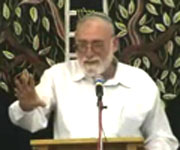Beit Midrash
- Torah Portion and Tanach
- Shmot
- Yitro
The Torah study is dedicatedin the memory of
Simha bat Hana
The haftara’s "heading" dates it as having taken place in the year that King Uziyah died. However, Rashi, based on the Targum, explains that the death refers to his affliction with leprosy, which is compared to death. Divrei Hayamim (II, 26:16-19) tells how Uziyah haughtily entered the Beit Hamikdash to offer incense (he was not a kohen), for which he was punished with leprosy. Also, the navi, Amos, apparently made his last recorded prophecy at that time. He began to prophesy two years before "the earthquake" (Amos 1:1) and his last prophecy mentions the earthquake. Finally, the prophecy of our haftara, including the words, "the pillars of the doorposts swayed from the noise of the caller, and the house was filled with smoke" (Yeshaya 6:4) took place on the day of the earthquake (Seder Rabba 20).
This earthquake made a deep impression on the mindset of generations of Jerusalemites. Zecharia, a navi during the Persian period, hundreds of years later, used it to describe the events of the day of the future geula. "On that day, My feet will stand on the Mount of Olives … the mountain will be split … and you will flee as you fled from the earthquake in the days of Uziyah" (Zecharia 14: 4-5). It is interesting that both Amos and Yeshaya, in the context of discussing the earthquake, also mention another natural calamity- great waves of sea water that crash into the coast, washing out places of inhabitation (see Yeshaya 5:8 and Amos (5: 25-30).
Our parasha’s revelation at Har Sinai took place in the context of the giving of the Torah. This raised Bnei Yisrael and, as a result, the whole world to a new spiritual level and presented us with the challenge to improve the world by having it accept Divine Dominion. The Ten Commandments light the way for a Jew no matter where he goes. Yeshaya, whose revelation was a continuation of that at Sinai, spoke of world peace, with Yerushalayim serving as the spiritual center of a united world. Amos completed his prophecy with a call for social morality, a call that mankind has not yet succeeded in implementing.
We are not on the level to understand how Hashem runs His world and are still shocked by the terrible tragedy that struck the shores of the Indian Ocean. With the proper humility appropriate for these times, we pray for the renewal of prophecy and improvement of the world, based on Divine Revelations that have enriched the world, from the giving of the Ten Commandments on.























